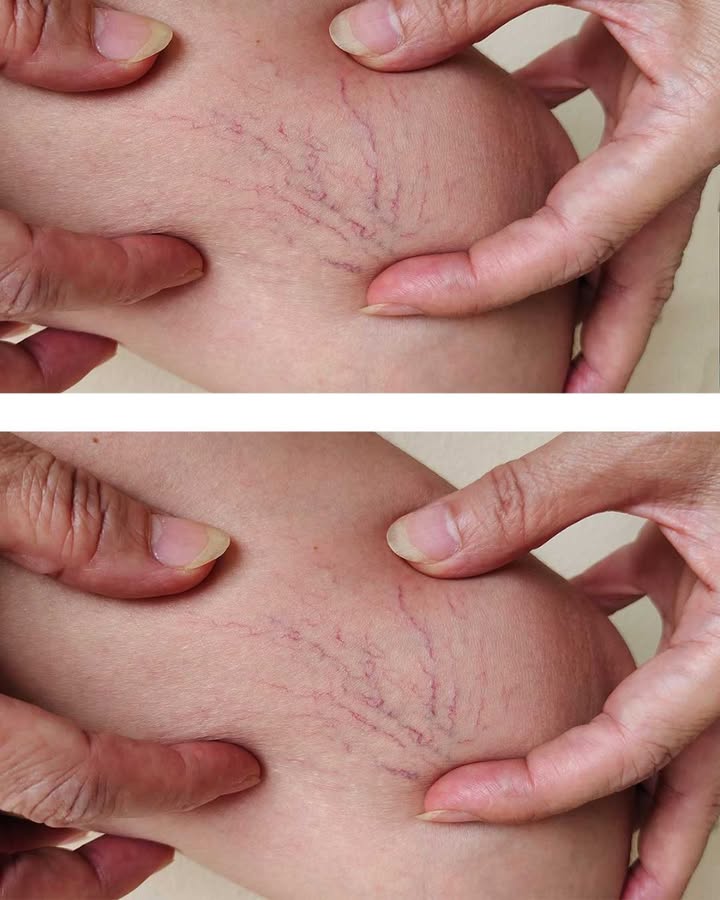ADVERTISEMENT
### **1. Understanding the Condition: What Are Those Red Veins on Your Thighs?**
The veins that appear on the surface of the skin can be classified into two types: **varicose veins** and **spider veins**. Both can affect the thighs, and though they may seem alarming, they are typically not a sign of an immediate health emergency.
#### **Spider Veins**
Spider veins are small, dilated blood vessels that appear on the surface of the skin. They often have a red, blue, or purple appearance and can spread in a web-like pattern. Spider veins are usually harmless but can be a sign of poor circulation or other underlying issues. They are often caused by hormonal changes, pregnancy, prolonged sitting or standing, or genetics.
#### **Varicose Veins**
Varicose veins are larger, swollen veins that appear darker and more prominent than spider veins. They may bulge out of the skin and cause discomfort, including pain, heaviness, and swelling. While varicose veins are common, especially in older adults or pregnant women, they can also be caused by obesity, a sedentary lifestyle, or prolonged periods of standing.
Both conditions occur when the valves inside the veins, which are responsible for preventing blood from flowing backward, become weak or damaged. This causes blood to pool in the veins, leading to their expansion and the visible appearance of red or blue veins.
### **2. Common Causes of Red Veins on the Thighs**
There are several reasons you might notice red veins spreading across your thighs. Some of these causes are relatively benign, while others might require more attention. Here are the most common reasons for the appearance of visible veins:
#### **A. Genetics and Family History**
A strong family history of vein problems can increase your likelihood of developing similar issues. If your parents or grandparents had varicose veins or spider veins, you might be genetically predisposed to developing them as well.
#### **B. Hormonal Changes**
Hormones play a significant role in the development of spider and varicose veins. Women are more likely to experience this condition due to hormonal changes that occur during pregnancy, menstruation, or menopause. Increased levels of estrogen can weaken the vein walls and make blood flow less efficient, causing veins to become more visible.
#### **C. Prolonged Sitting or Standing**
People who spend a lot of time sitting or standing without moving may develop visible veins. This includes individuals working at desks for long periods, those in retail or service industries, and anyone who spends much of their day on their feet. Lack of movement can lead to poor circulation and increased pressure in the veins, contributing to their enlargement.
#### **D. Obesity and Weight Gain**
Carrying excess weight puts added pressure on the veins in your legs. This can increase the likelihood of blood pooling and the development of varicose veins. Reducing weight through healthy eating and regular exercise may help alleviate or prevent the condition.
#### **E. Age**
As we age, our veins naturally lose elasticity and their walls weaken. This can lead to reduced blood flow and the development of visible veins. Aging also reduces the production of collagen and elastin, which help maintain the integrity of the veins.
#### **F. Pregnancy**
Pregnancy can lead to visible veins due to hormonal fluctuations, the increased volume of blood in the body, and the pressure that a growing uterus places on the veins. Many women experience spider veins or varicose veins during pregnancy, especially in the later stages.
For Complete Cooking STEPS Please Head On Over To Next Page Or Open button (>) and don’t forget to SHARE with your Facebook friends
ADVERTISEMENT
ADVERTISEMENT
